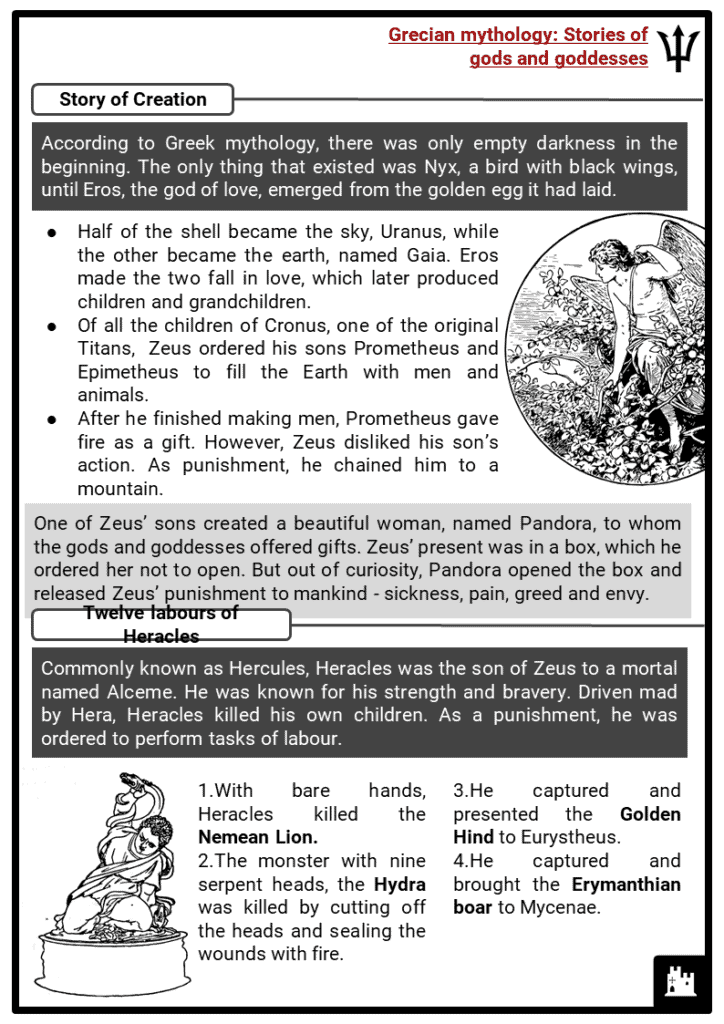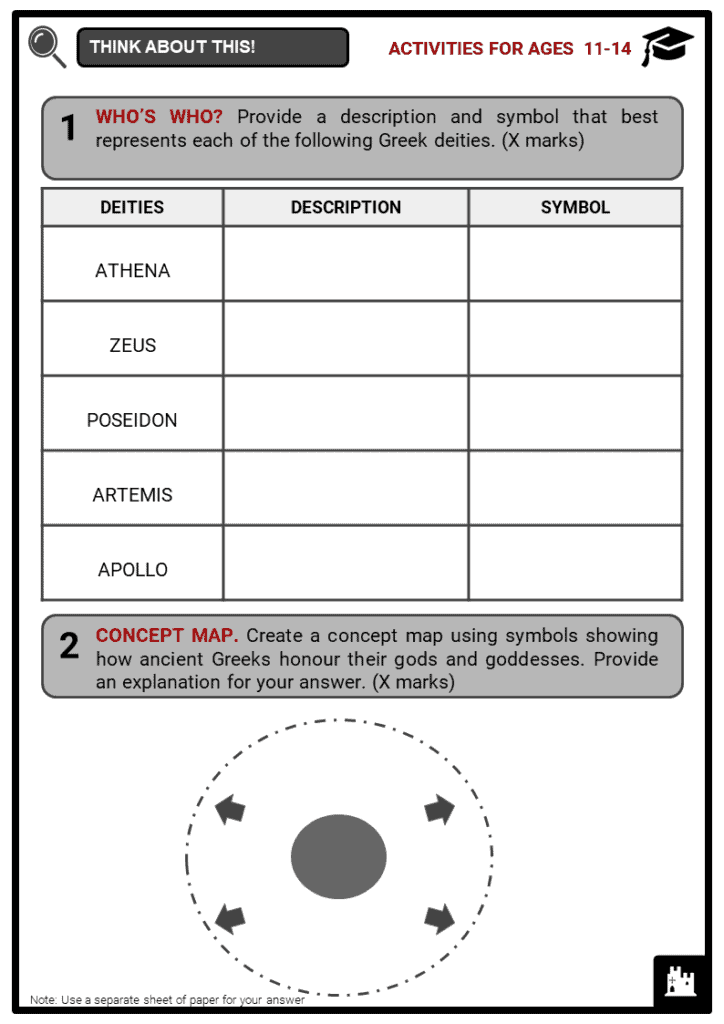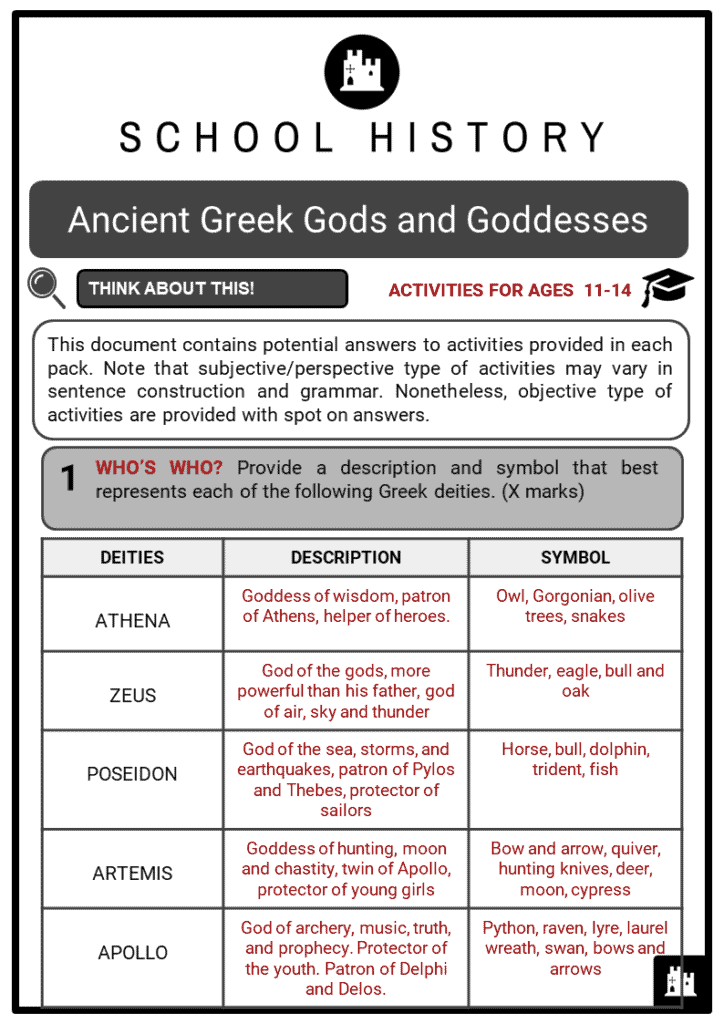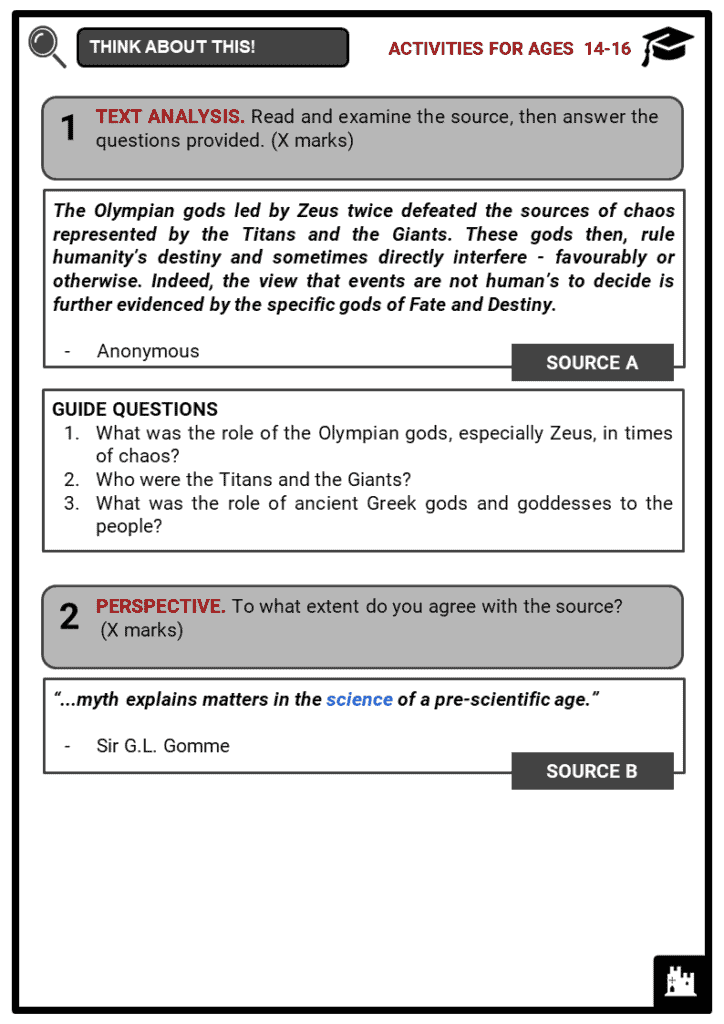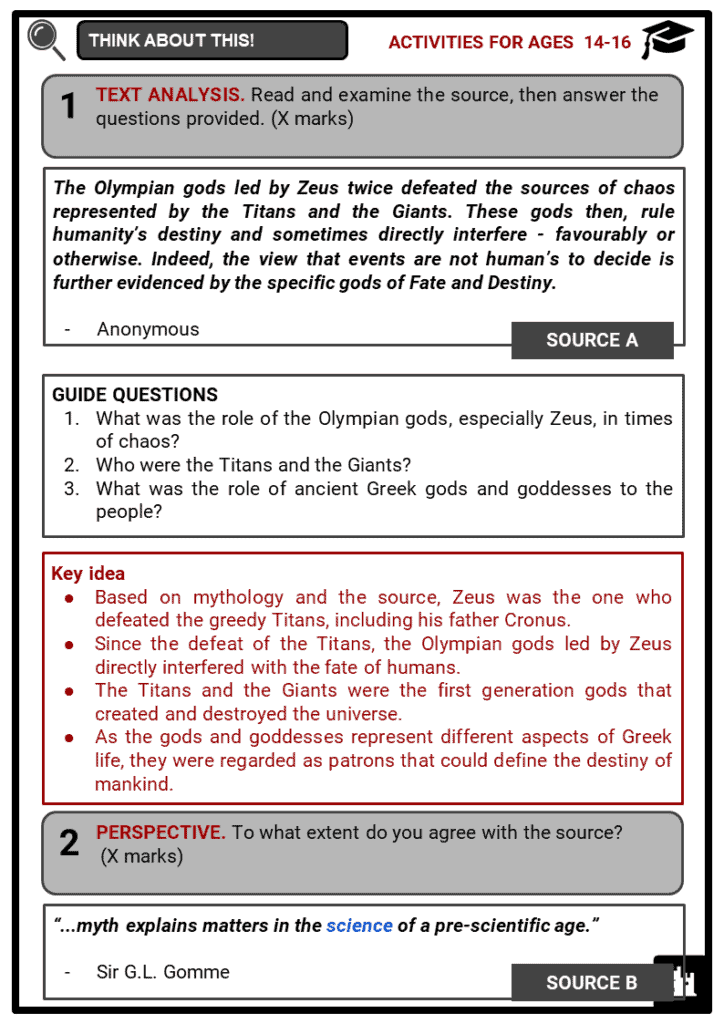Download Ancient Greek Gods and Goddesses Worksheets
Do you want to save dozens of hours in time? Get your evenings and weekends back? Be able to teach Ancient Greek Gods and Goddesses to your students?
Our worksheet bundle includes a fact file and printable worksheets and student activities. Perfect for both the classroom and homeschooling!
Table of Contents
Add a header to begin generating the table of contents
Summary
- The legend of Romulus and Remus
- Structure of the Roman Republic
- The Roman Empire: Society and the Triumvirates
- Decline and fall of an empire
- The Five Good Roman Emperors
Key Facts And Information
Let’s know more about ancient Rome!
- In the 8th century, a small civilization along the Tiber River located in central Italy grew to be one of the largest empires in history. At the height of the Roman Empire, its territory encompassed the continents of Europe, parts of western Asia, northern Africa, and the Mediterranean. By the 5th century AD, the once greatest empire saw its decline. Among the legacies left by this enormous civilization was the widespread use of Romance languages from Latin roots, including Italian, French Portuguese, Romanian, and Spanish.
Grecian mythology: Stories of gods and goddesses
Story of Creation
- According to Greek mythology, there was only empty darkness in the beginning. The only thing that existed was Nyx, a bird with black wings, until Eros, the god of love, emerged from the golden egg it had laid.
- Half of the shell became the sky, Uranus, while the other became the earth, named Gaia. Eros made the two fall in love, which later produced children and grandchildren.
- Of all the children of Cronus, one of the original Titans, Zeus ordered his sons Prometheus and Epimetheus to fill the Earth with men and animals.
- After he finished making men, Prometheus gave fire as a gift. However, Zeus disliked his son’s action. As punishment, he chained him to a mountain.
- One of Zeus’ sons created a beautiful woman, named Pandora, to whom the gods and goddesses offered gifts. Zeus’ present was in a box, which he ordered her not to open. But out of curiosity, Pandora opened the box and released Zeus’ punishment to mankind - sickness, pain, greed and envy.
Twelve labours of Heracles
- Commonly known as Hercules, Heracles was the son of Zeus to a mortal named Alceme. He was known for his strength and bravery. Driven mad by Hera, Heracles killed his own children. As a punishment, he was ordered to perform tasks of labour.
- With bare hands, Heracles killed the Nemean Lion.
- The monster with nine serpent heads, the Hydra was killed by cutting off the heads and sealing the wounds with fire.
- He captured and presented the Golden Hind to Eurystheus.
- He captured and brought the Erymanthian boar to Mycenae.
- He rerouted the rivers Alpheus and Peneus to clean the poisonous Augean Stables.
- Using a rattle, he slayed the violent Stymphalian birds.
- With bare hands, he wrestled with the Cretan Bull.
- By digging a ditch to calm down Diomedes’ flesh-eating mares, Heracles was able to sew their mouths and return them back to Eurystheus.
- Deceived by Hera, Hippolyta (Queen of the Amazons) attempted to kill Hercules to protect the precious belt. However, Heracles killed her and took the belt.
- He stole the cattle of the giant Geryon.
- In order to steal the apples of the Hesperides, the evening nymphs, Heracles asked the help of god Atlas, who was then holding up the heavens.
- He killed the three-headed dog, Cerberus, that guarded the entrance of the underworld.
Perseus: The Slayer of Gorgon Medusa
- Son of Danae (daughter of Acrisius, King of Argos) and Zeus, Perseus was mentioned in an oracle that he would cause the death of his grandfather. As a result, Perseus and Danae were cast off the sea using a wooden cast. When the cast reached the shore of Serifos, both were made slaves by King Polydectes.
- Medusa was born a mortal. Her exceptional beauty led Poseidon to impregnate her while at the Temple of Athena. Because of this, Athena cursed Medusa with snakes for hair and exiled her to a cave.
- As part of the curse, all who gazed on Medusa would turn to stone.
- With the help of Hermes, Athena, and Hades, Perseus beheaded Medusa. The Gorgon's head was then used to rescue Andromeda, an Ethiopian princess, from a sea monster named Cetus.
- Perseus sought the help of the Graeae, the three sisters of the Gorgons who shared a single eye and a tooth among them.
The Tragedy of Oedipus
- According to an oracle, Oedipus, son of King Laius of Thebes and Jocasta, would kill his father. Due to the prophecy, the king ordered a servant to tether his son’s ankles and abandon him on a mountaintop.
- Despite the king’s order, the servant saved Oedipus by giving him to a shepherd. Young Oedipus was soon adopted by King Polybus of Corinth.
- At Delphi, Oedipus discovered his fate through an oracle. While on his way to Thebes, he encountered King Laius and killed him.
- During this time, Thebes was ruled by Creon, Jocasta’s brother. Creon promised that whoever can solve the riddle of the Sphinx would gain the kingdom of Thebes. Oedipus solved the riddle, became the ruler of Thebes, and married Jocasta.
- Oedipus only discovered that he killed his father and married his mother when Thebes was plagued. As an oracle exposed the cause of the plague, Jocasta hung herself out of disgust.
- Upon seeing the dead body of Jocasta, Oedipus stabbed his eyes and was sent to exile.
Troy and the Trojan Horse
- One of the most interesting war stories among the Greeks was the Trojan War. The conflict began when Paris, a Trojan prince, abducted Helen, wife of Menelaus of Sparta.
- When the Trojans refused to send Helen back, Menelaus persuaded his brother Agamemnon to attack Troy. Agamemnon and his troops, including heroes Achilles, Patroclus, Odysseus and Ajax, sailed to Troy.
- After years of battle, the Greeks deceived the Trojans by sending a huge wooden horse as a gift.
- The horse concealed a small group of skilled warriors.
- The final year of the war was depicted in Homer’s Iliad. Historians believe that this epic war probably reflected a real war that occurred between the invading Greeks and people of Troas in 1200 BC, because of control over the Dardanelles.
Greek deities: The Twelve Olympians
Genealogy of major Greek deities based on mythology
- Ancient Greeks practised polytheism, meaning they believed and worshipped several gods and goddesses that represented certain aspects of human life. For the ancient Greeks, religion guided their personal and everyday life. These deities were depicted in human form and characters. Most of the time, they directly intervened in human affairs and even bore child with them.
- There were said to be 12 or 13 deities that comprised the list of Olympian gods. In Greek mythology, they were the major deities that resided on Mount Olympus. The Elder gods or Titan gods were the ruler of the cosmos prior to the Olympian gods.
- To honour their gods and goddesses, ancient Greeks built temples or naos and designated them as patrons of cities. For example, Aphrodite, the goddess of beauty, passion and love, was the patron of the city of Corinth.
ZEUS
- According to ancient Greek religion, Zeus was the sky and thunder god and the youngest of the sons of Cronus and Rhea. Etymologically, his Roman equivalent name was Jupiter, who possessed the same power.
- He was seen as the god who maintained order, and the ruler upon all gods. He assigned each deity its roles. Although Zeus did not physically father many gods, he was considered the father of them all.
- His union with Hera, his sister, produced other gods, including Ares, Hebe and Hephaestus. He was also the father of many deities and heroes, such as Apollo, Artemis, Hermes, Athena, Perseus and Heracles.
- In addition to thunder, he was also characterised by animal imagery, like an eagle, bull and oak.
- According to mythology, Zeus grew greater and more powerful than his father. He was the reason why his other siblings escaped their father’s stomach. He also freed the Cyclopes and Cronus’ brothers from Tartarus.
- Then, Zeus collaborated with his brothers and sisters, Cyclopes and Hecatonchires, to overthrow Cronus. They also cast the Titans to Tartarus, which was a region in the underworld. One myth recounts that there was a Titan punished by holding the sky, because he fought against Zeus.
- As a result of overthrowing the Titans, Zeus and his brothers shared the responsibilities of the world. Zeus was accountable for the sky and air. Poseidon got the waters, and Hades the underworld.
HERA
- Hera is the goddess of marriage, women, family and childbirth in ancient Greek religion. She is the wife and sister of Zeus. Hera is given the title “queen of the gods”, for she rules over Mount Olympus.
- In ancient Greek mythology, Hera can be demonstrated by a cow, lioness and the peacock.
- The Greeks devoted the first temple constructions to honour the goddess Hera. Her first temple was built at Samos about 800 BCE. Later, it was replaced by a bigger temple called the Heraion of Samos.
- Hera was famous for being the matron goddess. Ancient Greek mythology tells that her marriage to Zeus was conducted in sacred marriage rituals. These marriage rituals were carried by the Greeks, and they believed that Hera presided over weddings. Grecians carved a great sculpture of Hera seated as a bride.
POSEIDON
- Poseidon’s Roman equivalent is Neptune. Poseidon is the god of the sea, storms and earthquakes. In Pylos and Thebes, he was regarded as a chief deity.
- He was thought to be the protector of sailors. His mythology recounts that he stood with the Greeks against the Trojans, during the “Trojan War“. However, a Greek hero Odysseus incited Poseidon’s fury by blinding his son.
- Poseidon appeared as a beast (a horse-like beast), demonstrating the world of the dead “river spirit”. Greeks believed that when earthquakes happened, they reflected Poseidon’s anger. Shipwrecking and storms at sea were also attributed to his mood.
- Poseidon more than other Greeks. They usually prayed and asked for safe voyages. Ancient Greeks have performed rituals to honour Poseidon when sailing. These religious rituals included animal sacrifices, like sinking horses. He was symbolised by a horse, bull, dolphin, trident and a fish.
DEMETER
- Demeter is the Greek goddess of agriculture, fertility, sacred law and the harvest. She was named “she of the grain”, and the “lawbringer”. She also persisted on the cycle of life and death.
- Demeter was worshipped at Eleusis, a little town near Athens, and celebrated with two main festivals. Demeter had a very close bond to her daughter Persephone. Myths recount that Persephone was also the daughter of Zeus. Persephone was named the “queen of the underworld”.
- Another story argues that Persephone, the virgin, was kidnapped by Hades, the god of the underworld. Her mother searched for her non-stop. In effect, all the living plants in nature were left to dry and die.
ATHENA
- Athena is the Greek goddess of wisdom and war. Athena’s role was to protect many cities in ancient Greek, especially the city of Athens.
- Most of her sculptures usually depict her wearing a helmet, and holding a spear.
- Athena is symbolised by owls, the Gorgonian, olive trees and snakes.
- Athena had temples built for her in the central part of the city, on the top of the fortified Acropolis. In addition to the Parthenon, Greeks constructed other numerous temples to honour Athena across ancient Greece.
- Aside from being the goddess of wisdom, Athena was also known as the helper of heroes. In mythology, she guided Odysseus on his journey back to Ithaca. Moreover, other heroes, such as Heracles, Perseus, Diomedes, Cadmus and Bellerophon also received help from Athena.
APOLLO
- Apollo is the son of Zeus and Leto. He was born in Mount Cynthus on the island of Delos and was represented by a python, raven, lyre, laurel wreath, swan, bows and arrows.
- Apollo is the god of archery, truth and prophecy, healing and diseases, music and dance, the Sun and light, poetry and art.
- It was believed that Apollo was the protector of the young. He healed them, and helped them grow. Apollo is also associated with children’s education.
- Delphi and Delos are the cult centres of Apollo. Many temples were built for Apollo in Greece, as well as in Greek colonies.
- In ancient Greek mythology, Apollo is often depicted with his Muses at Olympus. He uses his lyre made by god Hermes. Paeans were hymns often sung to honour Apollo.
- Based on Homer’s Iliad, Apollo infected the Greek encampment with plague.
ARTEMIS
- Artemis is the Greek goddess of hunting, wild animals, the wilderness, moon, and chastity. She is the twin sister of Apollo, and the daughter of Zeus and Leto. Artemis was pictured with many symbols including a bow, arrow, quiver, hunting knives, moon, deer and cypress.
- Ancient Greeks believed that Artemis could curse women with grief or relief. In the same way Apollo was the protector of children, Artemis protected young girls.
- She was worshiped side by side with Eileithyia, as the deity of childbirth and midwifery. Stories recount that Artemis preferred to remain a virgin.
- Artemis’ temple was considered one of the seven wonders of the ancient world.
ARES
- Son of Zeus and Hera, Ares is the god of war. He is often personified with violence, conflict, and other brutal aspects of war. Similar to his sister, Athena, he represents military strategies.
- His symbols are the sword, chariot, flaming torch, spear, shield, helmet, dog, boar and vulture.
- Unlike Athena, there were minimal temples built to honour him. Among the remarkable was a statue built in Sparta, which highlighted the military spirit of the city-state.
- Despite the rarity of temples, Ares was often honoured with sacrifices when the Greeks were going to war.
APHRODITE
- Aphrodite is the goddess of love, pleasure, procreation, passion, fertility and beauty. She is symbolised by myrtles, sparrows, roses, doves and swans. Aphrodite is the daughter of Zeus and Dione.
- The Aphrodisia was the main festival celebrated in honour of Aphrodite. This festival was celebrated annually. Greek priests would spill the blood of doves in the temple, as a sacrifice.
- In mythology the beauty of Aphrodite sparked wars between gods. In order to avoid conflict, Zeus married her to Hephaestus.
- Along with Hera and Athena, Aphrodite was one of the contenders for a golden apple in the story of the Judgement of Paris. When Zeus refused to choose who was the fairest of the three, Paris, son of the King of Troy, chose Aphrodite.
- Aphrodite is often depicted as a perfect maiden, a female counterpart of Apollo. She is sometimes represented alongside Eros due to their ability to ignite love.
HEPHAESTUS
- Hephaestus is the Greek god of blacksmithing, metalworking and craftsmen. He made all the weapons and armouries of the gods in Olympus, and so is symbolised by a hammer, tongs, a volcano and an anvil.
- Compared to other gods, Hephaestus was the only one depicted with physical deformities. Because of this imperfection, he was initially cast out of heaven.
- His marriage to Aphrodite was arranged by Zeus.
- In addition to being the god of metalworking, Hephaestus was considered to be the patron of the arts.
- A temple in Athens was built to honour him. The arrow of Eros and armour of Achilles were both crafted by Hephaestus.
HERMES
- Hermes is the god of travel, communication, commerce and diplomacy. He is also known as the messenger of the gods. Hermes’ role is to protect merchants, orators and travellers. It is believed that he can travel quickly between worlds (divine world, human world and the underworld).
- Son of Zeus and Maia. Myths depicted Hermes as the “trickster God” who is symbolised by a rooster, winged helmet, tortoise, lyre and talaria.
- Ancient Greeks worshiped him as he “who connects the living with the dead”.
- Hermes was highly honoured in the city-states of Corinth and Argos. In Arcadian and Boeotian art, Hermes is depicted carrying a ram, which associated him with the patron of shepherds.
HESTIA
- Hestia, firstborn of Cronus and Rhea, is the goddess of the hearth, fire, the home, and the state. Hestia highlighted the social, religious, and political stability. Her duty was to provide domestic and religious care for the family. She symbolises warmth.
- To honour Hestia, every city in ancient Greece had a public hearth. Inside Greek homes, meals began and ended by making an offering to her.
- Despite her small appearance in mythology, Hestia is considered the most compassionate of all the gods and goddesses.
- Despite the intentions of Poseidon and Apollo, Hestia refused to get married. She remained childless and devoted herself to caring for Greek families.


